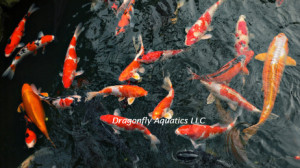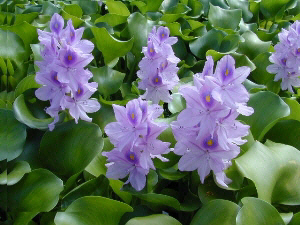My sister and I have played around with miniature gardens for quite a few years now. We both started out with a miniature trough garden, placed by our ponds with a garden fairy or two. Each year we would purchase more minature trees, plants and fairies. The miniature gardens got larger, adding houses, pathways and of course more fairies. This year we have both taken the Miniature Gardening to a whole new level. We have added water features to our Miniature Gardens! One is a miniature pond surrounded by fairy benches with a dry creek bed and the other is a waterfall cascading down a slight slope into a pond with even miniature water lettuce floating on top. I can't believe how cute they are!
 We've checked everything out in our ponds but what about our fish? The fish are swimming and coming to the top of the pond. Don't be in a hurry to feed them. The proper time to begin feeding the fish is when the water temperatures consistently reach at least 50 degrees and above.
We've checked everything out in our ponds but what about our fish? The fish are swimming and coming to the top of the pond. Don't be in a hurry to feed them. The proper time to begin feeding the fish is when the water temperatures consistently reach at least 50 degrees and above.
On the few warmer days of spring they will come to the surface acting as if they want fed. The water should be stabilized around 50 degrees before you resume feeding. You will want to feed them an easily digestible food, such as a wheat-germ-based floating pellet to start with, since their digestive systems are still slow. Microbe-Lift makes a Fall/Spring Fish food that is wheat germ and easily digested. Feed the fish in the morning, feeding them lightly at first so that they will digest their food before the temperature lowers at night for a couple weeks. Once the water temperatures rise above 55 degrees, resume feeding them their normal high-protein food. Any good quality fish food with vitamins will work. Another good choice food for fish is duckweed or azolla. I always put some duckweed in a container in the shade so it grows and multiplies. That way I have it for a treat all summer long. I have heard also that frozen peas are good for fish. I haven't tried that but thinking about it now I will. Just to see if my fish like it.
You may want to add some flake food or balls of cooked oatmeal to your feeding regiment for the baby fish, once they start to appear in early spring.
You will want to make sure your pond water isn't high in ammonia or nitrites for your fish. You can buy test kits to check for this. I always check all the fish for any signs of infection or disease in the early spring so I can treat them before it gets worse. We sell a medicated floating fishfood that works well in treating fish. It is always easier to see the fish in the early spring, before the plants are in the pond.
 Water gardening is easy with floating plants. Just place in the water and they drift effortlessly in your pond. The roots of floating plants dangle down into the water where they draw nutrients for the plant's growth. Floating plants provide shade for your pond while creating a place for fish to hide under to protect them from the hot summer sun. They also give them a place to hide from predators, such as herons or raccoons. The greatest benefit of floating plants is they help with your ponds filtration.
Water gardening is easy with floating plants. Just place in the water and they drift effortlessly in your pond. The roots of floating plants dangle down into the water where they draw nutrients for the plant's growth. Floating plants provide shade for your pond while creating a place for fish to hide under to protect them from the hot summer sun. They also give them a place to hide from predators, such as herons or raccoons. The greatest benefit of floating plants is they help with your ponds filtration.
Some of the floating plants, such as water lettuce, water hyacinth and parrots feather are good for filtrating. Their tiny hairy roots absorb nitrates and phosphates from the water and help in creating a good filtration. By taking these nutrients in it prohibits algae growth and green water. Azolla and duckweed are also filtration plants. Your other floating plants, such as sensitive plant and frogbit will only filter nutrients from the water and don't help combat green water.
Remember not to place floating water plants in your pond until the water temperature have reached 65 degrees. They will show signs of yellowing leaves and black spots on their leaves if left in water temps below that. We tend to get anxious in the spring and sometimes put floaters in before the water is warm enough.
If you want to try and keep them over the winter you may try floating them in a tray or aquarium. Its difficult and not always successful but worth a try if you so desire. You need to keep the water around 70 degrees and they need about 12-14 hours of sunlight. With it being hard to get that much sunlight during the months of January and February you would have to keep a growing light on them about 12 inches over the water. You may find that its cheaper just to replace them yearly due to the cost of energy and electricity required to keep them growing over the winter.
Caring for these plants is minimal and a great asset for your pond. Some states discouraged or even ban them from possession due to their growth rate and spreading rate. You should never add to a natural body of water. If you aren't sure about your area make sure you compost them into your vegetable bed. You can always check with your state regarding the laws that prohibit these plants.